Cow Milk versus Plant-Based Milk Substitutes: A Comparison of Product Image and Motivational Structure of Consumption
Abstract
1. Introduction
2. Trends and Sustainability Challenges in the Global Market for Dairy and Plant Milk
3. Literature Review on Consumer Studies about Cow Milk and Plant Milk
- RQ1.
- Is there a difference in the product image of cow milk and plant milk?
- RQ2.
- Is the assessment of the product image influenced by the consumption versus non-consumption of plant milk?
- RQ3.
- Is health consciousness influencing the product image evaluation of cow milk and plant milk?
- RQ4.
- Which motives are determining the consumption of plant milk in comparison to cow milk?
- RQ5.
- Are environmental aspects and animal-welfare important motives for the consumption of cow milk and plant milk?
4. Materials and Methods
4.1. Materials and Methods for Study 1
- I pay attention to a healthy diet.
- I avoid alcohol.
- I avoid cigarettes.
- Regular consultations with doctors are important to me.
- Regular physical training is important to me.
- I am a health-conscious person.
4.2. Materials and Methods for Study 2
5. Results
5.1. Study 1: Results of the Product Image Analysis
5.1.1. Sample Description of the Product Image Analysis
5.1.2. Health Consciousness
5.1.3. Product Image Analysis
5.2. Results of the Means-End Chain Analysis
5.2.1. Sample Description of Means-End Chain Analysis
5.2.2. Means-End Chain Analysis
- The indulgence ladder.
- The health ladder and wellness ladder.
- The environmental ladder.
- The animal welfare ladder.
- The variety/flexibility ladder.
- The price ladder.
- The indulgence ladder (with a wellness aspect).
- The health ladder.
- The flexibility/convenience ladder.
- The habit/tradition ladder.
- The support farmers and national economy ladder.
6. Discussion and Conclusions
6.1. Discussion About Product Image Analysis
6.2. Discussion About Means-End Chain Analysis
6.3. Limitations and Future Research
6.4. Conclusions
Author Contributions
Funding
Acknowledgments
Conflicts of Interest
Appendix A
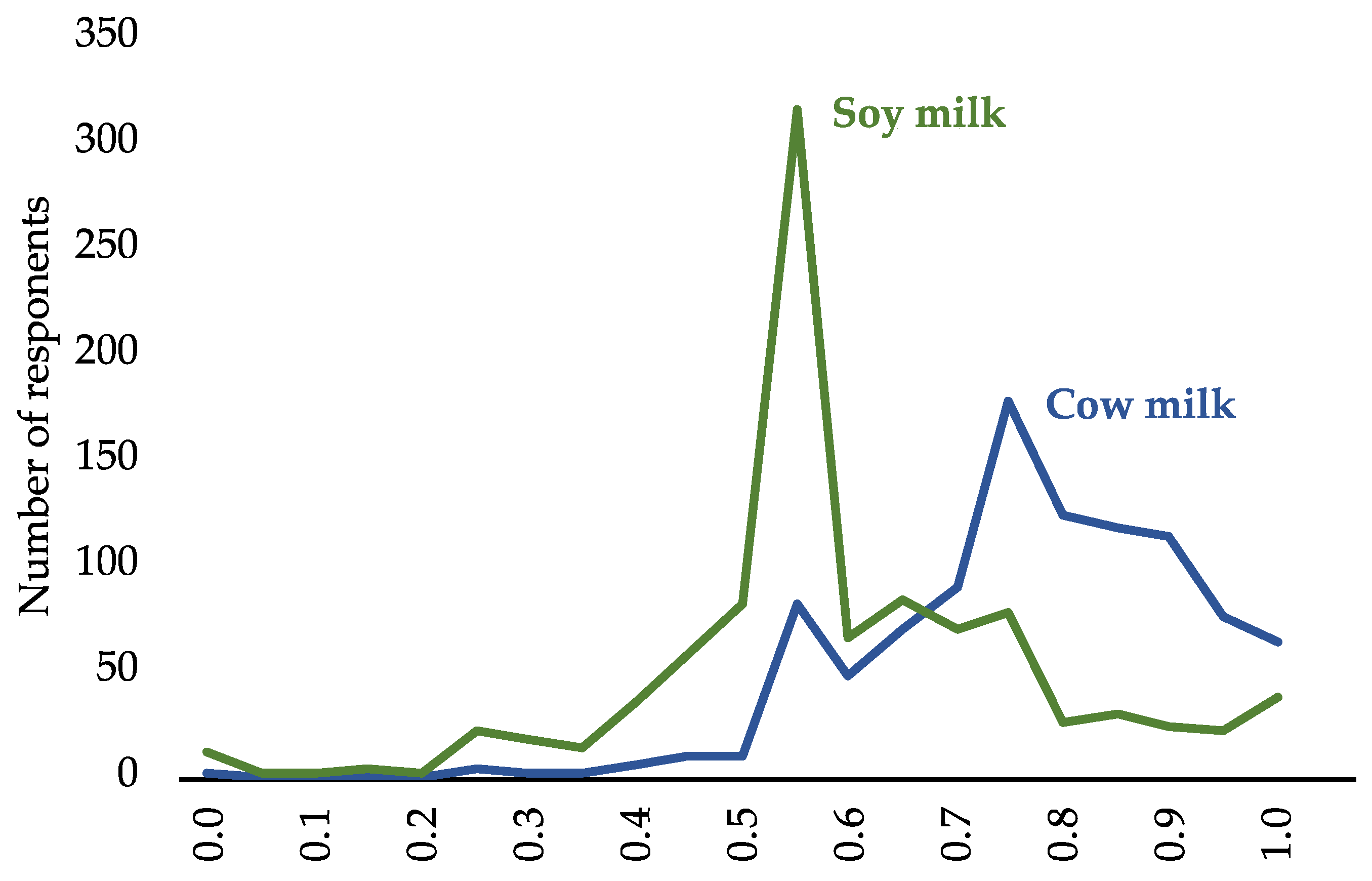
| Item | Md | SE | DF | t | Sig. | Bootstrap 2 | ||
|---|---|---|---|---|---|---|---|---|
| 95% Confidence Interval | Sig. | |||||||
| fresh–preserved 1 | +0.252 | 0.187 | 52.102 | 1.389 | 0.171 | −0.089 | 0.628 | 0.196 |
| healthy–unhealthy 1 | +0.442 | 0.164 | 51.774 | 2.728 | 0.009 | 0.150 | 0.776 | 0.009 |
| good for bones–bad for bones | +0.157 | 0.140 | 999 | 1.398 | 0.163 | −0.085 | 0.459 | 0.272 |
| natural–artificial 1 | +0.197 | 0.154 | 51.909 | 1.304 | 0.198 | −0.081 | 0.538 | 0.204 |
| digestible–indigestive | +0.560 | 0.170 | 999 | 4.010 | ≤0.001 | 0.230 | 0.899 | 0.003 |
| valuable–worthless | +0.379 | 0.154 | 999 | 3.261 | ≤0.001 | 0.097 | 0.702 | 0.017 |
| rich in minerals–poor in minerals | +0.113 | 0.146 | 999 | 0.901 | 0.368 | −0.151 | 0.414 | 0.457 |
| tastes good–tastes bad | +0.247 | 0.182 | 999 | 1.614 | 0.107 | −0.072 | 0.622 | 0.176 |
| light–fatty | −0.031 | 0.154 | 999 | −0.224 | 0.823 | −0.352 | 0.256 | 0.843 |
| energetic–powerless 1 | +0.301 | 0.158 | 51.976 | 1.918 | 0.061 | 0.036 | 0.639 | 0.048 |
| allergy-free–allergenic 1 | +0.635 | 0.169 | 52.486 | 3.788 | ≤0.001 | 0.292 | 0.971 | 0.002 |
| Image Cow Milk × Hx 1 | Pear-Son’s r | Sig. | Bootstrap 2 95% Confidence Interval | Spear-Man-Rho | Sig. | Bootstrap 2 95% Confidence Interval | ||
| fresh–preserved | 0.128 | ≤0.001 | 0.059 | 0.195 | 0.150 | ≤0.001 | 0.089 | 0.208 |
| healthy–unhealthy | 0.166 | ≤0.001 | 0.098 | 0.231 | 0.180 | ≤0.001 | 0.118 | 0.239 |
| good for bones–bad for bones | 0.201 | ≤0.001 | 0.134 | 0.266 | 0.206 | ≤0.001 | 0.144 | 0.266 |
| natural–artificial | 0.099 | 0.002 | 0.031 | 0.168 | 0.106 | 0.001 | 0.039 | 0.169 |
| digestible–indigestive | 0.090 | 0.004 | 0.026 | 0.155 | 0.103 | 0.001 | 0.033 | 0.159 |
| valuable–worthless | 0.153 | ≤0.001 | 0.087 | 0.216 | 0.168 | ≤0.001 | 0.107 | 0.226 |
| rich in minerals–poor in minerals | 0.188 | ≤0.001 | 0.123 | 0.253 | 0.185 | ≤0.001 | 0.125 | 0.245 |
| tastes good–tastes bad | 0.135 | ≤0.001 | 0.066 | 0.196 | 0.122 | ≤0.001 | 0.064 | 0.183 |
| light–fatty | 0.154 | ≤0.001 | 0.089 | 0.216 | 0.125 | ≤0.001 | 0.057 | 0.185 |
| energetic–powerless | 0.189 | ≤0.001 | 0.122 | 0.256 | 0.202 | ≤0.001 | 0.135 | 0.258 |
| allergy-free–allergenic | 0.131 | ≤0.001 | 0.066 | 0.197 | 0.113 | ≤0.001 | 0.046 | 0.173 |
| Ix | −0.218 | ≤0.001 | −0.281 | −0.154 | −0.232 | ≤0.001 | −0.288 | −0.167 |
| Image Soy Milk × Hx 1 | Pear-Son’s r | Sig. | Bootstrap 2 95% Confidence Interval | Spear-Man-Rho | Sig. | Bootstrap 2 95% Confidence interval | ||
| fresh–preserved | 0.150 | ≤0.001 | 0.089 | 0.208 | 0.096 | 0.002 | 0.038 | 0.159 |
| healthy–unhealthy | 0.180 | ≤0.001 | 0.118 | 0.239 | 0.150 | ≤0.001 | 0.087 | 0.210 |
| good for bones–bad for bones | 0.206 | ≤0.001 | 0.144 | 0.266 | 0.177 | ≤0.001 | 0.116 | 0.237 |
| natural–artificial | 0.106 | 0.001 | 0.039 | 0.169 | 0.104 | 0.001 | 0.043 | 0.168 |
| digestible–indigestive | 0.103 | 0.001 | 0.033 | 0.159 | 0.114 | ≤0.001 | 0.053 | 0.180 |
| valuable–worthless | 0.168 | ≤0.001 | 0.107 | 0.226 | 0.162 | ≤0.001 | 0.101 | 0.229 |
| rich in minerals–poor in minerals | 0.185 | ≤0.001 | 0.125 | 0.245 | 0.153 | ≤0.001 | 0.092 | 0.218 |
| tastes good–tastes bad | 0.122 | ≤0.001 | 0.064 | 0.183 | 0.139 | ≤0.001 | 0.074 | 0.201 |
| light–fatty | 0.125 | ≤0.001 | 0.057 | 0.185 | 0.056 | 0.078 | −0.009 | 0.119 |
| energetic–powerless | 0.202 | ≤0.001 | 0.135 | 0.258 | 0.116 | ≤0.001 | 0.057 | 0.177 |
| allergy-free–allergenic | 0.113 | ≤0.001 | 0.046 | 0.173 | 0.107 | 0.001 | 0.045 | 0.172 |
| Ix | −0.232 | ≤0.001 | −0.288 | −0.167 | −0.169 | ≤0.001 | −0.234 | −0.100 |
| Plant Milk Consumers % | Cow Milk Consumers % | ||
|---|---|---|---|
| Age | 15–29 | 53.3% | 40.0% |
| 30–49 | 33.3% | 33.3% | |
| 50 or older | 13.3% | 26.7% | |
| Gender | Male | 16.7% | 40.0% |
| Female | 83.3% | 60.0% | |
| Education | Compulsory School | - | - |
| Middle/Vocational School | 10.0% | 3.4% | |
| High School | 36.7% | 48.3% | |
| Higher Education | 53.3% | 48.3% | |
| Household size | Single | 23.3% | 23.3% |
| Two people | 56.7% | 56.7% | |
| Three people | 10.0% | 10.0% | |
| Four people or more | 10.0% | 10.0% |
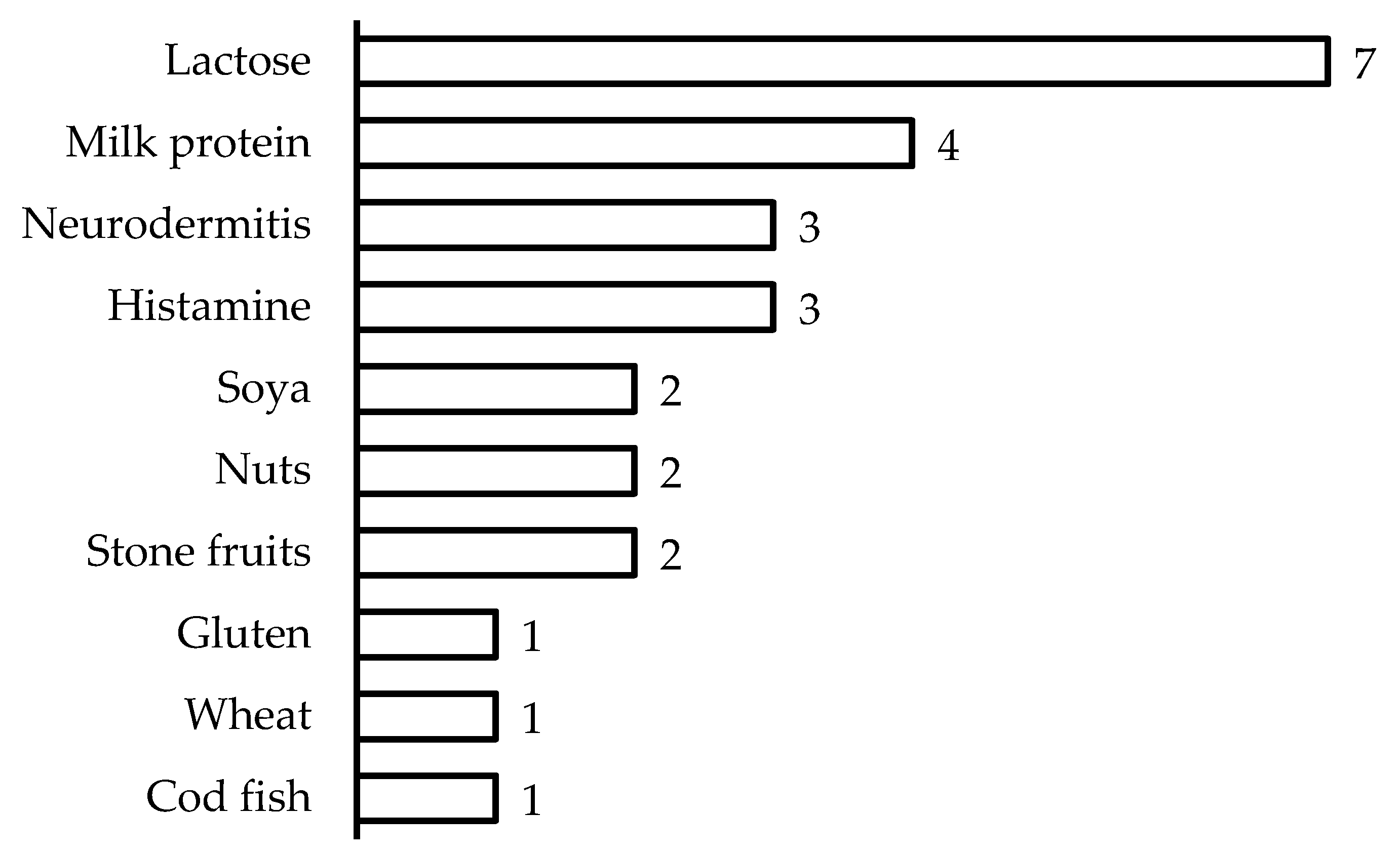
References
- Rozenberg, S.; Body, J.J.; Bruyère, O.; Bergmann, P.; Brandi, M.L.; Cooper, C.; Devogelaer, J.P.; Gielen, E.; Goemaere, S.; Kaufman, J.M.; et al. Effects of Dairy Products Consumption on Health: Benefits and Beliefs—A Commentary from the Belgian Bone Club and the European Society for Clinical and Economic Aspects of Osteoporosis, Osteoarthritis and Musculoskeletal Diseases. Calcif. Tissue Int. 2016, 98, 1–17. [Google Scholar] [CrossRef]
- Elmadfa, I.; Freisling, H. Food-based dietary guidelines in Austria. Ann. Nutr. Metab. 2007, 51, 8–14. [Google Scholar] [CrossRef]
- Centre for European Agricultural Studies and The European Forum on Nature Conservation and Pastoralism. The Environmental Impact of Dairy Production in the EU: PRACTICAL Options for the Improvement of the Environmental Impact. Available online: https://ec.europa.eu/environment/agriculture/pdf/dairy.pdf (accessed on 20 May 2019).
- European Environmental Agency. Household Consumption and the Environment; EEA: Copenhagen, Denmark, 2005; ISBN 929167768X. [Google Scholar]
- Pistrich, K.; Wendtner, S.; Janetschek, H. Versorgung Österreichs Mit Pflanzlichem Eiweiß—Fokus Sojakomplex. Available online: https://www.dafne.at/prod/dafne_plus_common/attachment_download/d709373b9b5e9badcfb18587e974a30b/SR107_Soja.pdf (accessed on 23 January 2019).
- Good, K. Milk Life? How About Milk Destruction: The Shocking Truth About the Dairy Industry and the Environment. Available online: https://www.onegreenplanet.org/animalsandnature/the-dairy-industry-and-the-environment/ (accessed on 11 May 2019).
- PETA. 12 Reasons to Stop Drinking Cow’s Milk. Available online: https://www.peta.org/living/food/reasons-stop-drinking-milk/ (accessed on 11 May 2019).
- Wolfe, D. Milk Is Not Good for Your Bones. This Is Why! Available online: https://www.davidwolfe.com/milk-is-bad-for-bones/ (accessed on 20 July 2019).
- Rayburn, E. Research Shows No Matter Which Plant-Based Milk You Try, It Will Always Be More Environmentally-Friendly Than Dairy. Available online: https://www.onegreenplanet.org/news/plant-based-milk-try-will-always-environmentally-friendly-dairy/ (accessed on 28 July 2019).
- Plant Based News World Plant Milk Day. 22 August 2019. Available online: https://www.worldplantmilkday.com (accessed on 28 July 2019).
- Clayton, A. Milk. Available online: https://www.ethicalconsumer.org/food-drink/shopping-guide/milk (accessed on 20 July 2019).
- Chen, S. Preparation of Fluid Soymilk. In Proceedings of the World Congress on Vegetable Protein Utilization in Human Foods and Animal Feedstuffs; Applewhite, T.H., Ed.; American Oil Chemists’s Society: Champaign, IL, USA, 1989; pp. 341–352. [Google Scholar]
- Mäkinen, O.E.; Wanhalinna, V.; Zannini, E.; Arendt, E.K. Foods for Special Dietary Needs: Non-dairy Plant-based Milk Substitutes and Fermented Dairy-type Products. Crit. Rev. Food Sci. Nutr. 2016, 56, 339–349. [Google Scholar] [CrossRef] [PubMed]
- Derbyshire, E.J. Flexitarian Diets and Health: A Review of the Evidence-Based Literature. Front. Nutr. 2016, 3, 55. [Google Scholar] [CrossRef] [PubMed]
- Mintel Group US. Sales of Dairy Milk Turn Sour as Non-Dairy Milk Sales Grow 9% in 2015. Available online: https://www.mintel.com/press-centre/food-and-drink/us-sales-of-dairy-milk-turn-sour-as-non-dairy-milk-sales-grow-9-in-2015 (accessed on 11 May 2019).
- Dünnebacke, T. Getränke, Eine Regelrechte Explosion. Available online: https://lebensmittelpraxis.de/getraenke/24028-getraenke-eine-regelrechte-explosion.html (accessed on 28 July 2019).
- Palacios, O.M.; Badran, J.; Drake, M.A.; Reisner, M.; Moskowitz, H.R. Consumer acceptance of cow’s milk versus soy beverages: Impact of ethnicity, lactose tolerance and sensory preference segmentation. J. Sens. Stud. 2009, 24, 731–748. [Google Scholar] [CrossRef]
- Palacios, O.M.; Badran, J.; Spence, L.; Drake, M.A.; Reisner, M.; Moskowitz, H.R. Measuring Acceptance of Milk and Milk Substitutes Among Younger and Older Children. J. Food Sci. 2010, 75, 522–526. [Google Scholar] [CrossRef] [PubMed]
- Villegas, B.; Carbonell, I.; Costell, E. Acceptability of milk and soymilk vanilla beverages: Demographics consumption frequency and sensory aspects. Food Sci. Technol. Int. 2009, 15, 203–210. [Google Scholar] [CrossRef]
- McCarthy, K.S.; Parker, M.; Ameerally, A.; Drake, S.L.; Drake, M.A. Drivers of choice for fluid milk versus plant-based alternatives: What are consumer perceptions of fluid milk? J. Dairy Sci. 2017, 100, 6125–6138. [Google Scholar] [CrossRef]
- FAO. Dairy Sector Global Facts. Available online: https://www.fil-idf.org/wp-content/uploads/2016/12/FAO-Global-Facts-1.pdf (accessed on 11 May 2019).
- Alexandratos, N.; Bruinsma, J. World Agriculture towards 2030/2050. Available online: http://www.fao.org/3/a-ap106e.pdf (accessed on 11 May 2019).
- Zingone, F.; Bucci, C.; Iovino, P.; Ciacci, C. Consumption of milk and dairy products: Facts and figures. Nutrition 2017, 33, 322–325. [Google Scholar] [CrossRef]
- Statistics Market Research Consulting Dairy Alternatives—Global Market Outlook (2017–2023). Available online: https://www.researchandmarkets.com/reports/4426299/dairy-alternatives-global-market-outlook-2017#rela0-4386954 (accessed on 29 July 2019).
- Allied Market Research Dairy Alternative Market by Source (Soy Milk, Almond Milk, Rice Milk, Other Sources), Application (Food and Beverage)—Global Opportunity Analysis and Industry Forecast, 2014–2022. Available online: https://www.alliedmarketresearch.com/dairy-alternative-market (accessed on 10 May 2019).
- Chiorando, M. Sales of Vegan Food Skyrocket To $3.3 Billion in One Year. Available online: https://www.plantbasednews.org/post/sales-of-vegan-food-skyrocket-3-3-billion (accessed on 12 May 2019).
- Vierhile, T. How Other Milk Alternatives Are Gaining on Soy Milk in US—Analysis. Available online: https://www.just-food.com/analysis/how-other-milk-alternatives-are-gaining-on-soy-milk-in-us-analysis_id132209.aspx (accessed on 14 February 2019).
- EC. EU Agricultural Outlook for Markets and Income, 2018–2030; EC: Brussels, Belgium, 2018. [Google Scholar]
- Pichelbauer, M. Pflanzen-Kunde. Produkt—Der Informationsservice für Handel, Gastronomie & Markenartikler, 6 July 2015; 21. [Google Scholar]
- Jeske, S.; Zannini, E.; Arendt, E.K. Past, present and future: The strength of plant-based dairy substitutes based on gluten-free raw materials. Food Res. Int. 2018, 110, 42–51. [Google Scholar] [CrossRef]
- European Commission. Milk and Milk Products in the European Union. Available online: https://ec.europa.eu/agriculture/publi/fact/milk/2007_en.pdf (accessed on 20 January 2019).
- Barilla Center for Food and Nutrition Double Pyramid. 2016 Eat Better Eat Less Food for All. Available online: https://www.barillacfn.com/m/publications/doublepyramid2016-more-sustainable-future-depends-on-us.pdf (accessed on 29 May 2019).
- Stiftung Heinrich Böll Fleischatlas—Daten und Fakten über Tiere als Nahrungsmittel. Available online: https://www.bund.net/fileadmin/user_upload_bund/publikationen/massentierhaltung/massentierhaltung_fleischatlas_2018.pdf (accessed on 29 May 2019).
- Clune, S.; Crossin, E.; Verghese, K. Systematic review of greenhouse gas emissions for different fresh food categories. J. Clean. Prod. 2017, 140, 766–783. [Google Scholar] [CrossRef]
- Ercin, A.E.; Aldaya, M.M.; Hoekstra, A.Y. The water footprint of soy milk and soy burger and equivalent animal products. Ecol. Indic. 2012, 18, 392–402. [Google Scholar] [CrossRef]
- Cardinale, B.J.; Duffy, J.E.; Gonzalez, A.; Hooper, D.U.; Perrings, C.; Venail, P.; Narwani, A.; Mace, G.M.; Tilman, D.; Wardle, D.A.; et al. Biodiversity loss and its impact on humanity. Nature 2012, 486, 59–67. [Google Scholar] [CrossRef] [PubMed]
- IDH and IUCN NL European Soy Monitor. Available online: https://www.idhsustainabletrade.com/uploaded/2019/04/European-Soy-Monitor.pdf (accessed on 20 July 2019).
- Burrows, D. How Danone’s Alpro is Future-Proofing Its Soy Supply: Local Sourcing Direct from Farmers. Available online: https://www.foodnavigator.com/Article/2019/02/01/How-Danone-s-Alpro-is-future-proofing-its-soy-supply-local-sourcing-direct-from-farmers (accessed on 29 July 2019).
- Willett, W.; Rockström, J.; Loken, B.; Springmann, M.; Lang, T.; Vermeulen, S.; Garnett, T.; Tilman, D.; Declerck, F. The Lancet Commissions Food in the Anthropocene: The EAT—Lancet Commission on healthy diets from sustainable food systems. Lancet 2019, 3293, 447–492. [Google Scholar] [CrossRef]
- Saner, E. Almond Milk: Quite Good for You—Very Bad for the Planet. Available online: https://www.theguardian.com/lifeandstyle/shortcuts/2015/oct/21/almond-milk-quite-good-for-you-very-bad-for-the-planet (accessed on 27 May 2019).
- Bundesministerin für Gesundheit und Frauen (Federal Ministry of Health and Women). Verordnung der Bundesministerin für Gesundheit und Frauen über Rohmilch und Rohrahm (Rohmilchverordnung); Federal Ministry of Health and Women: Vienna, Austria, 2006.
- Bus, A.; Worsley, A. Consumers’ sensory and nutritional perceptions of three types of milk. Public Health Nutr. 2003, 6, 201–208. [Google Scholar] [CrossRef]
- Haas, R.; Canavari, M.; Imami, D.; Gjonbalaj, M.; Gjokaj, E.; Zvyagintsev, D. Attitudes and Preferences of Kosovar Consumer Segments Toward Quality Attributes of Milk and Dairy Products. J. Int. Food Agribus. Mark. 2016, 28, 407–426. [Google Scholar] [CrossRef]
- Tuorila, H. Selection of milks with varying fat contents and related overall liking, attitudes, norms and intentions. Appetite 1987, 8, 1–14. [Google Scholar] [CrossRef]
- Brewer, J.L.; Blake, A.J.; Rankin, S.A.; Douglass, L.W. Theory of reasoned action predicts milk consumption in women. J. Am. Diet. Assoc. 1999, 99, 39–44. [Google Scholar] [CrossRef]
- Lea, E.J.; Crawford, D.; Worsley, A. Consumers’ readiness to eat a plant-based diet. Eur. J. Clin. Nutr. 2006, 60, 342–351. [Google Scholar] [CrossRef]
- Harel, Z.; Riggs, S.; Vaz, R.; White, L.; Menzies, G. Adolescents and calcium: What they do and do not know and how much they consume. J. Adolesc. Heal. 1998, 22, 225–228. [Google Scholar] [CrossRef]
- Chapman, K.M.; Chan, M.W.; Clark, C.D. Factors Influencing Dairy Calcium Intake in Women. J. Am. Coll. Nutr. 1995, 14, 336–340. [Google Scholar] [CrossRef] [PubMed]
- Sousa, A.; Bolanz, K.A.K. Nutritional Implications of an Increasing Consumption of Non-Dairy Plant-Based Beverages Instead of Cow’s Milk in Switzerland. Adv. Dairy Res. 2017, 5, 2. [Google Scholar] [CrossRef]
- Vainio, A.; Niva, M.; Jallinoja, P.; Latvala, T. From beef to beans: Eating motives and the replacement of animal proteins with plant proteins among Finnish consumers. Appetite 2016, 106, 92–100. [Google Scholar] [CrossRef] [PubMed]
- Schyver, T.; Smith, C. Reported attitudes and beliefs toward soy food consumption of soy consumers versus nonconsumers in natural foods or mainstream grocery stores. J. Nutr. Educ. Behav. 2005, 37, 292–299. [Google Scholar] [CrossRef]
- Hajek, E. Food Intolerance—Fact or Fad? Available online: https://www.acv.at/presse/2016_PR_Food_intolerance___fact_or_fad.pdf (accessed on 13 February 2019).
- Hamilton, M. Eating Death. Food Cult. Soc. 2006, 9, 155–177. [Google Scholar] [CrossRef]
- Janssen, M.; Busch, C.; Rödiger, M.; Hamm, U. Motives of consumers following a vegan diet and their attitudes towards animal agriculture. Appetite 2016, 105, 643–651. [Google Scholar] [CrossRef] [PubMed]
- Leitzmann, C.; Keller, M. Vegetarische Ernährung; Ulmer UTB: Stuttgart, Germany, 2013; p. 380. ISBN 978-3-8252-3873-5. [Google Scholar]
- Radnitz, C.; Beezhold, B.; DiMatteo, J. Investigation of lifestyle choices of individuals following a vegan diet for health and ethical reasons. Appetite 2015, 90, 31–36. [Google Scholar] [CrossRef] [PubMed]
- Fox, N.; Ward, K. Health, ethics and environment: A qualitative study of vegetarian motivations. Appetite 2008, 50, 422–429. [Google Scholar] [CrossRef]
- Kerschke-Risch, P. Vegan Nutrition: Motives, Getting started and Duration. Ernahr. Umsch. 2015, 62, M330–M335. [Google Scholar]
- Haas, R.; Stern, J.; Meixner, O.; Nyob, D.I.; Traar, V. Do US Consumers’ perceive local and organic food differently? An analysis based on means-end chain analysis and word association. Int. J. Food Syst. Dyn. 2013, 4, 214–226. [Google Scholar]
- Cerjak, M.; Haas, R.; Brunner, F.; Tomić, M. What motivates consumers to buy traditional food products? Evidence from Croatia and Austria using word association and laddering interviews. Br. Food J. 2014, 116, 1726–1747. [Google Scholar] [CrossRef]
- Torrico, D.D.; Fuentes, S.; Viejo, C.G.; Ashman, H.; Dunshea, F.R. Cross-cultural effects of food product familiarity on sensory acceptability and non-invasive physiological responses of consumers. Food Res. Int. 2019, 115, 439–450. [Google Scholar] [CrossRef] [PubMed]
- Malik, M.E.; Naeem, B.; Munawar, M. Brand Image: Past, Present and Future. J. Basic Appl. Sci. Res. 2012, 2, 13069–13075. [Google Scholar]
- Kotler, P.; Keller, K.L. Marketing Management, 14th ed.; Pearson: London, UK, 2012; ISBN 9780132102926. [Google Scholar]
- Renner, B.; Sproesser, G.; Strohbach, S.; Schupp, H.T. Why we eat what we eat. The Eating Motivation Survey (TEMS ). Appetite 2012, 59, 117–128. [Google Scholar] [CrossRef] [PubMed]
- Preacher, K.J.; Hayes, A.F. Asymptotic and resampling strategies for assessing and comparing indirect effects in multiple mediator models. Behav. Res. Methods 2008, 40, 879–891. [Google Scholar] [CrossRef] [PubMed]
- Hoque, M.Z.; Alam, M.N. What determines the purchase intention of liquid milk during a food security crisis? The role of perceived trust, knowledge, and risk. Sustainability 2018, 10, 3722. [Google Scholar] [CrossRef]
- Hoek, A.C.; Luning, P.A.; Stafleu, A.; De Graaf, C. Food-related lifestyle and health attitudes of Dutch vegetarians, non-vegetarian consumers of meat substitutes, and meat consumers. Appetite 2004, 42, 265–272. [Google Scholar] [CrossRef]
- Schifferstein, H.N.J.; Ophuist, P.A.M.O. Health-related determinants of organic food consumption in The Netherlands. Food Qual. Prefer. 1997, 9, 119–133. [Google Scholar] [CrossRef]
- Siegrist, M.; Hartmann, C. Impact of sustainability perception on consumption of organic meat and meat substitutes. Appetite 2019, 132, 196–202. [Google Scholar] [CrossRef]
- Efron, B. The 1977 Rietz Lecture—Bootstrap methods: Another look at the jackknife. Ann. Stat. 1979, 7, 1–26. [Google Scholar] [CrossRef]
- DiCiccio, T.J.; Efron, B. Bootstrap confidence intervals. Stat. Sci. 1996, 11, 189–228. [Google Scholar]
- Reynolds, T.J.; Gutman, J. Laddering theory, method, analysis, and interpretation. J. Advert. Res. 1988, 28, 11–31. [Google Scholar]
- Gutman, J. A Means-End Chain Model Based on Consumer Categorization Processes. J. Mark. 1982, 46, 60–72. [Google Scholar] [CrossRef]
- Reynolds, T.C.; Olson, J.C. Understanding Consumer Decision Making. In The Means End Approach to Marketing and Advertising Strategy; Reynolds, T.C., Olson, J.C., Eds.; Lawrence Erlbaum Associates: Hillsdale, NJ, USA, 2001; p. 447. [Google Scholar]
- Audenaert, A.; Steenkamp, J.B. Means-end chain theory and laddering in agricultural marketing research. In Agricultural Marketing and Consumer Behavior in a Changing World; Wierenga, B., van Tilbury, A., Grunert, K., Steenkamp, J.B., Eds.; Kluwer Academics: Boston, MA, USA, 1997; pp. 217–230. [Google Scholar]
- Costa, A.I.A.; Dekker, M.; Jongen, W.M.F. An overview of means-end theory: Potential application in consumer-oriented food product design. Trends Food Sci. Technol. 2004, 15, 403–415. [Google Scholar] [CrossRef]
- Grunert, K.G.; Grunert, S.C. Measuring subjective meaning structures by the laddering method: Theoretical considerations and methodological problems. Int. J. Res. Mark. 1995, 12, 209–225. [Google Scholar] [CrossRef]
- Statistics Austria Population. Available online: http://www.statistik.at/web_en/statistics/PeopleSociety/population/index.html (accessed on 12 December 2018).
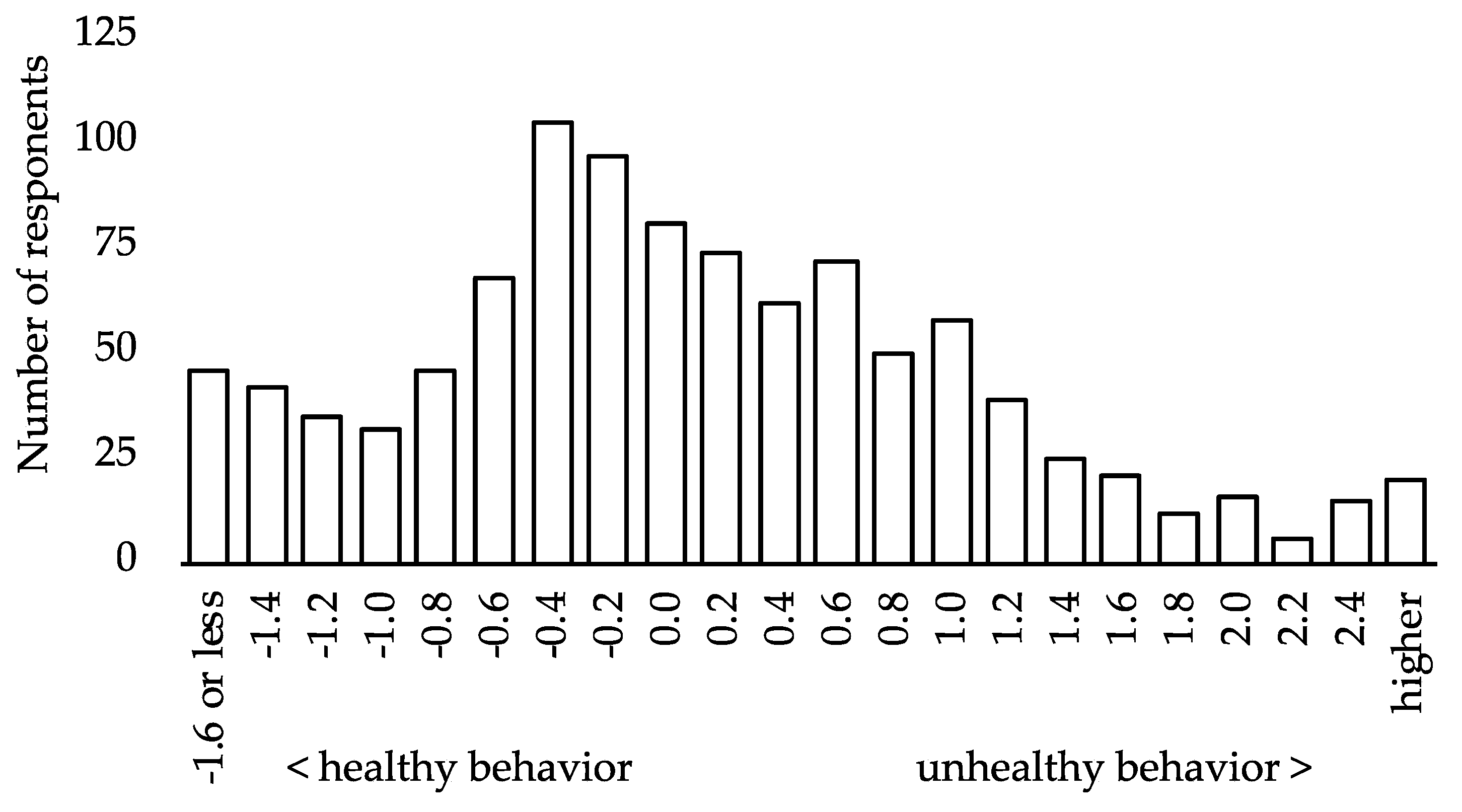
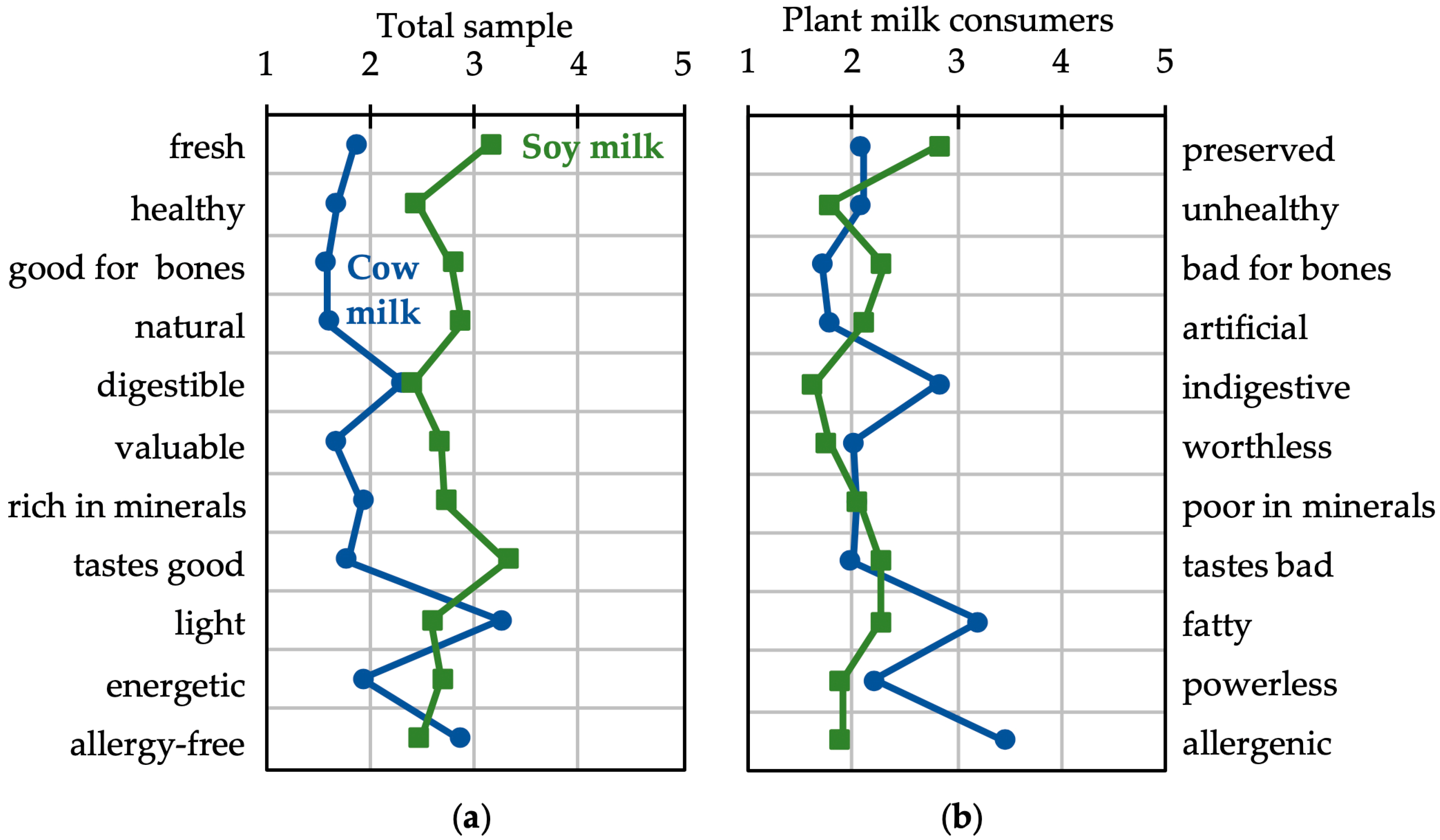
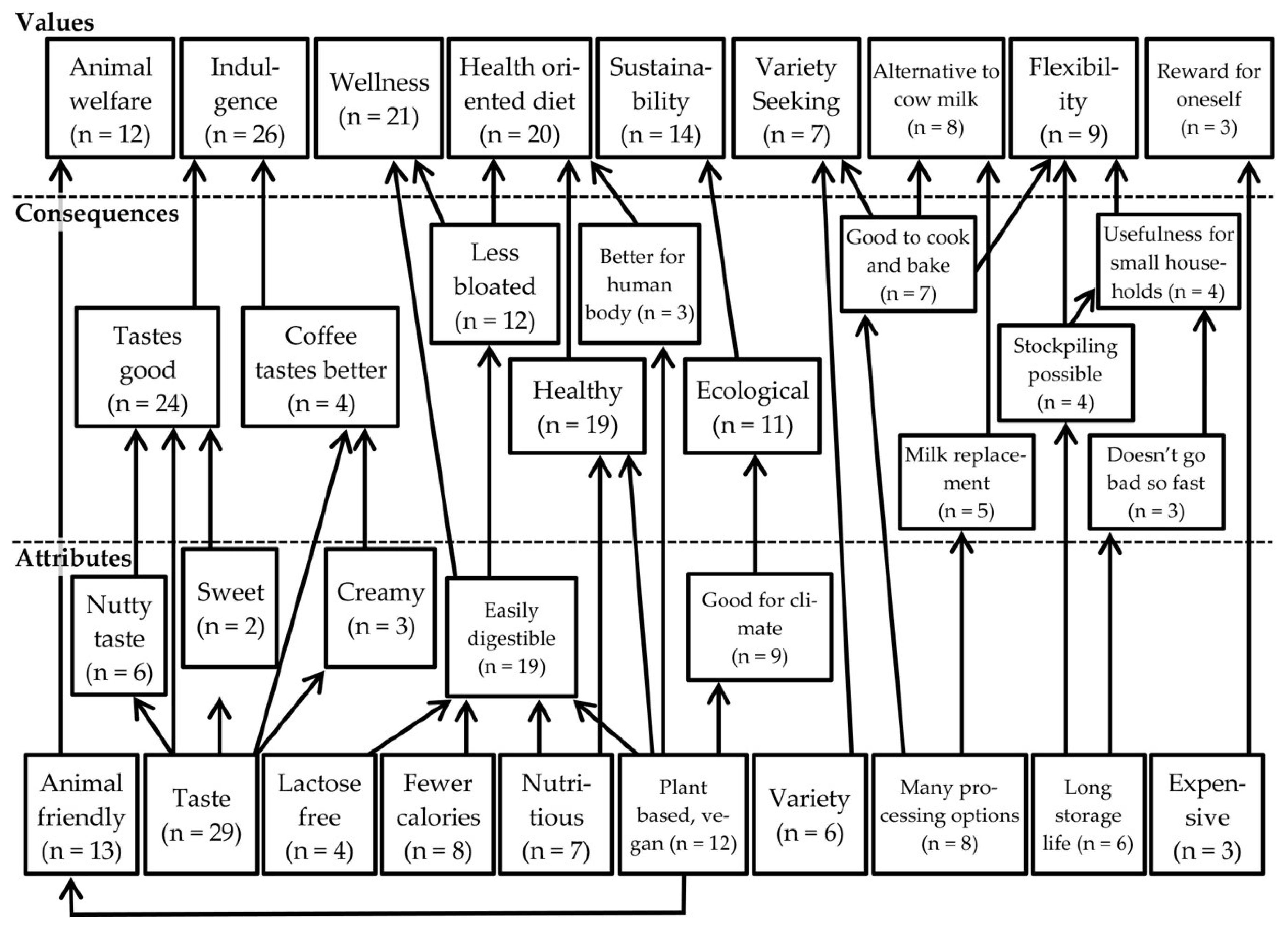
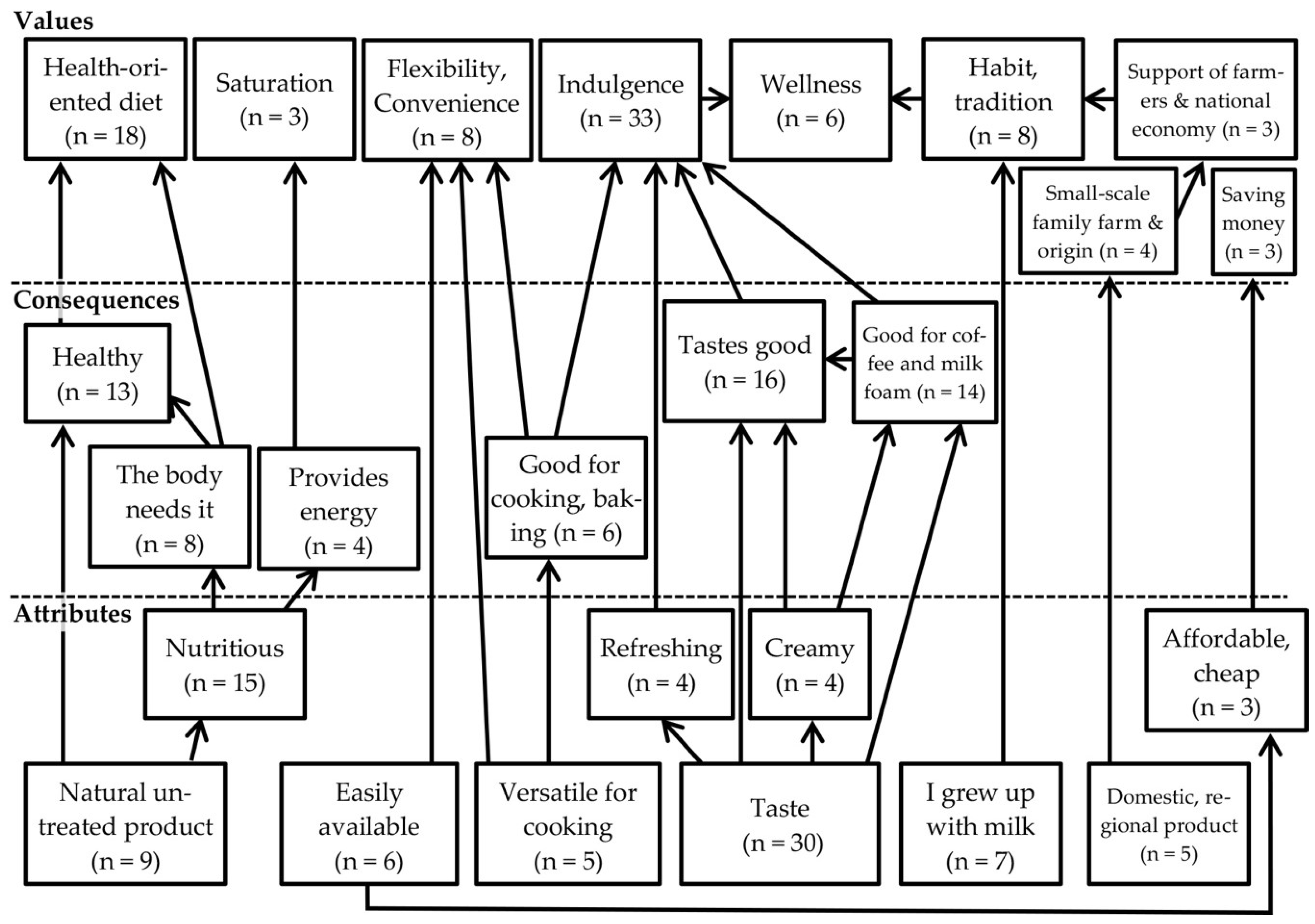
| Sample % | Austrian Population % (2016 [78]) | ||
|---|---|---|---|
| Age | 15–29 | 24.8 | 21.4 |
| 30–49 | 42.7 | 32.5 | |
| 50 or older | 32.6 | 46.1 | |
| Gender | Male | 48.5 | 49.1 |
| Female | 51.5 | 50.9 | |
| Education | Compulsory School | 25.5 | 18.3 |
| Middle/Vocational School | 46.7 | 49.2 | |
| High School | 18.5 | 15.4 | |
| Higher Education | 9.4 | 17.1 | |
| Household size | Single | 13.2 | 37.2 |
| Two people | 32.0 | 30.3 | |
| Three people | 24.9 | 14.9 | |
| Four people or more | 30.0 | 17.6 |
| M | Md | SE | 2t | Sig. | Bootstrap 3 | ||||
|---|---|---|---|---|---|---|---|---|---|
| Item/Index 1 | Cow | Soy | 95% Confidence Interval | Sig. | |||||
| fresh–preserved | 1.86 | 3.15 | −1.291 | 0.045 | −28.93 | ≤0.001 | −1.374 | −1.199 | ≤0.001 |
| healthy–unhealthy | 1.68 | 2.43 | −0.749 | 0.039 | −19.28 | ≤0.001 | −0.824 | −0.676 | ≤0.001 |
| good for bones–bad for bones | 1.57 | 2.79 | −1.219 | 0.033 | −36.85 | ≤0.001 | −1.285 | −1.156 | ≤0.001 |
| natural–artificial | 1.59 | 2.86 | −1.269 | 0.042 | −30.20 | ≤0.001 | −1.350 | −1.188 | ≤0.001 |
| digestible–indigestive | 2.31 | 2.41 | −0.103 | 0.045 | −2.26 | 0.024 | −0.186 | −0.019 | 0.019 |
| valuable–worthless | 1.66 | 2.67 | −1.010 | 0.039 | −25.87 | ≤0.001 | −1.083 | −0.937 | ≤0.001 |
| rich in minerals–poor in minerals | 1.93 | 2.72 | −0.787 | 0.038 | −20.95 | ≤0.001 | −0.863 | −0.713 | ≤0.001 |
| tastes good–tastes bad | 1.77 | 3.32 | −1.558 | 0.048 | −32.68 | ≤0.001 | −1.643 | −1.464 | ≤0.001 |
| light–fatty | 3.25 | 2.58 | 0.667 | 0.042 | 15.73 | ≤0.001 | 0.586 | 0.754 | ≤0.001 |
| energetic–powerless | 1.93 | 2.69 | −0.758 | 0.039 | −19.62 | ≤0.001 | −0.834 | −0.687 | ≤0.001 |
| allergy-free–allergenic | 2.86 | 2.47 | 0.386 | 0.044 | 8.67 | ≤0.001 | 0.296 | 0.475 | ≤0.001 |
| Ix 1-0 | 0.74 | 0.57 | 0.175 | 0.007 | 24.66 | ≤0.001 | 0.160 | 0.189 | ≤0.001 |
| Md | SE | DF | t | Sig. | Bootstrap 2 | |||
|---|---|---|---|---|---|---|---|---|
| Item/Index | 95% Confidence Interval | Sig. | ||||||
| fresh–preserved 1 | −0.327 | 0.187 | 52.476 | −1.750 | 0.086 | −0.694 | 0.067 | 0.090 |
| healthy–unhealthy | −0.684 | 0.140 | 999 | −4.886 | ≤0.001 | −0.912 | −0.453 | ≤0.001 |
| good for bones–bad for bones 1 | −0.515 | 0.134 | 52.933 | −3.835 | ≤0.001 | −0.778 | −0.263 | ≤0.001 |
| natural–artificial | −0.780 | 0.159 | 999 | −4.892 | ≤0.001 | −1.082 | −0.500 | ≤0.001 |
| digestible–indigestive 1 | −0.811 | 0.125 | 56.123 | −6.511 | ≤0.001 | −1.041 | −0.538 | ≤0.001 |
| valuable–worthless | −0.958 | 0.142 | 999 | −6.731 | ≤0.001 | −1.177 | −0.743 | ≤0.001 |
| rich in minerals–poor in minerals | −0.695 | 0.132 | 999 | −5.253 | ≤0.001 | −0.952 | −0.462 | ≤0.001 |
| tastes good–tastes bad | −1.099 | 0.162 | 999 | −6.780 | ≤0.001 | −1.416 | −0.755 | ≤0.001 |
| light–fatty | −0.318 | 0.133 | 999 | −2.397 | 0.017 | −0.554 | −0.081 | 0.010 |
| energetic–powerless | −0.834 | 0.141 | 999 | −5.912 | ≤0.001 | −1.096 | −0.566 | ≤0.001 |
| allergy-free–allergenic | −0.602 | 0.139 | 999 | −4.339 | ≤0.001 | −0.870 | −0.321 | ≤0.001 |
| Ix cow milk 1 | −0.074 | 0.032 | 51.446 | −2.413 | 0.019 | −0.135 | −0.012 | 0.033 |
| Ix soy milk | 0.173 | 0.023 | 999 | 6.715 | ≤0.001 | 0.129 | 0.218 | ≤0.001 |
© 2019 by the authors. Licensee MDPI, Basel, Switzerland. This article is an open access article distributed under the terms and conditions of the Creative Commons Attribution (CC BY) license (http://creativecommons.org/licenses/by/4.0/).
Share and Cite
Haas, R.; Schnepps, A.; Pichler, A.; Meixner, O. Cow Milk versus Plant-Based Milk Substitutes: A Comparison of Product Image and Motivational Structure of Consumption. Sustainability 2019, 11, 5046. https://doi.org/10.3390/su11185046
Haas R, Schnepps A, Pichler A, Meixner O. Cow Milk versus Plant-Based Milk Substitutes: A Comparison of Product Image and Motivational Structure of Consumption. Sustainability. 2019; 11(18):5046. https://doi.org/10.3390/su11185046
Chicago/Turabian StyleHaas, Rainer, Alina Schnepps, Anni Pichler, and Oliver Meixner. 2019. "Cow Milk versus Plant-Based Milk Substitutes: A Comparison of Product Image and Motivational Structure of Consumption" Sustainability 11, no. 18: 5046. https://doi.org/10.3390/su11185046
APA StyleHaas, R., Schnepps, A., Pichler, A., & Meixner, O. (2019). Cow Milk versus Plant-Based Milk Substitutes: A Comparison of Product Image and Motivational Structure of Consumption. Sustainability, 11(18), 5046. https://doi.org/10.3390/su11185046






